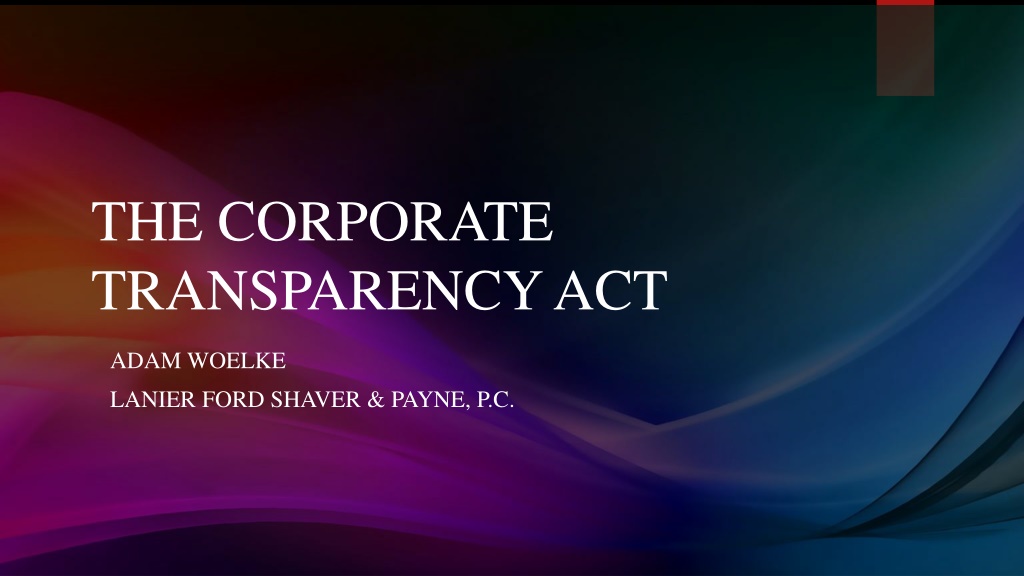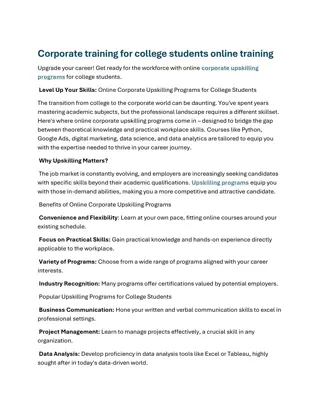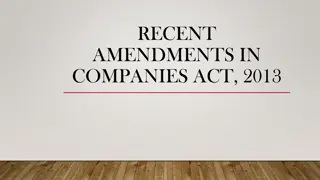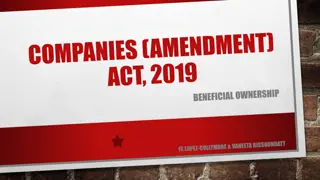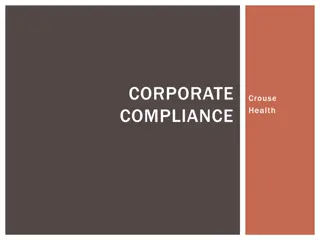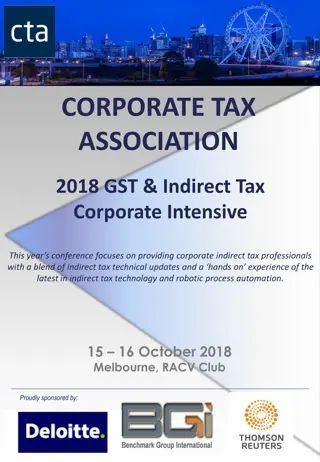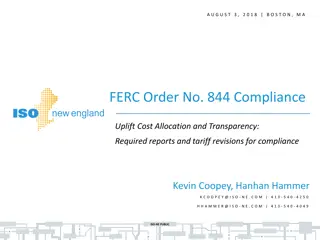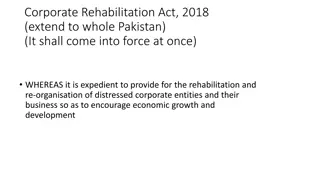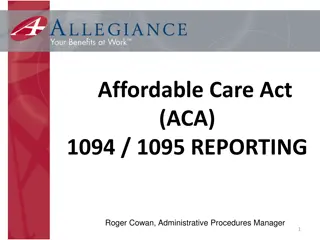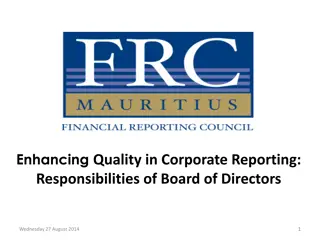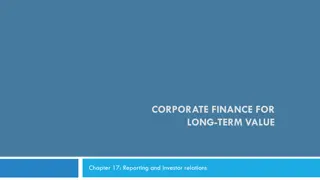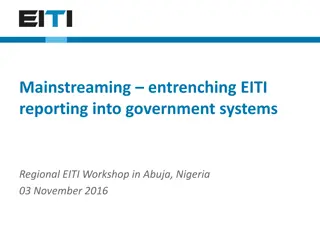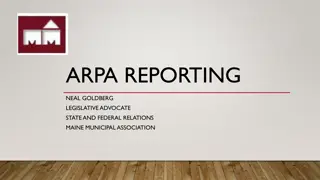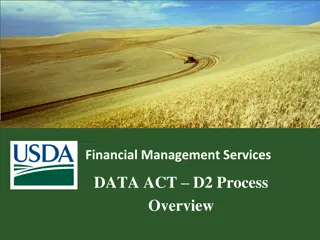Understanding the Corporate Transparency Act: Reporting and Compliance
The Corporate Transparency Act mandates businesses to submit Beneficial Ownership Information (BOI) reports to FinCEN to combat illegal activities like money laundering and terrorist financing. Non-compliance can lead to severe penalties, but safe harbor provisions offer protection for correcting information within 90 days. Reporting companies include corporations, LLCs, and entities formed under state or foreign laws.
Download Presentation

Please find below an Image/Link to download the presentation.
The content on the website is provided AS IS for your information and personal use only. It may not be sold, licensed, or shared on other websites without obtaining consent from the author. Download presentation by click this link. If you encounter any issues during the download, it is possible that the publisher has removed the file from their server.
E N D
Presentation Transcript
THE CORPORATE TRANSPARENCY ACT ADAM WOELKE LANIER FORD SHAVER & PAYNE, P.C.
Overview The Corporate Transparency Act requires businesses to file a Beneficial Ownership Information (BOI) Report. This report goes to the Department of Treasury s Financial Crimes Enforcement Network (FinCEN). The reason why the government is requiring BOI reports sent to FinCEN is because FinCEN is cracking down on illegal activities such as money laundering, tax fraud, corruption, and terrorist financing. The government believes that with higher levels of transparency around business ownership, this will prevent criminals from trying to hide illegal property, cash or capital gains in shell companies here in the United States.
Deadlines: Non-exempt reporting companies formed after January 1, 2024: 30 calendar days to file an initial beneficial ownership (BOI) report Non-exempt reporting companies formed before January 1, 2024: Have until January 1, 2025 to file their initial BOI reports.
Why is this important? There are penalties for non-compliance. Criminal and Civil Penalties: Any person that violates subparagraph (A) or (B) of paragraph (1) Shall be liable to the United States for a civil penalty of not more than $500 for each day that the violation continues or has not been remedied; and May be fined not more than $10,000, imprisoned for not more than 2 years, or both. Unauthorized disclosure or use violations. Any person that violates paragraph (2) Shall be liable to the United States for a civil penalty of not more than $500 for each day that the violation continues or has not been remedied; and Shall be fined not more than $250,000, or imprisoned for not more than 5 years, or both; or While violating another law of the United States or as part of a pattern of any illegal activity involving more than $100,000 in a 12-month period, shall be fined not more than $500,000, imprisoned for not more than 10 years, or both.
Safe Harbor and Self-Correction No liability if the report filer believed the report true and reports the corrected information within 90 days. FinCEN is obligated to provide assistance to a person trying to correct a prior report.
Reporting Company The CTA defines reporting company as: a corporation, limited liability company, or other entity that is (i) created by filing of a document with a secretary of state or any similar office under the law of a State or Indian Tribe; or (ii) formed under the law of a foreign country and registered to do business in any State or tribal jurisdiction by the filing of a document with a secretary of state or any similar office under the laws of a State or Indian Tribe.
Reporting Companies Special Examples Reporting company examples: Delaware Statutory Trusts General Partnerships in certain states Not a Reporting company: Individual life insurance trust (ILIT) General partnership (most states) Rabbi trust Maybe (check state law): Farm cooperative Purchasing coop
23 separate exemption types: Insurance company Securities reporting issuer State-licensed insurance producer Governmental authority Commodity Exchange Act entity Bank Accounting firm Credit Union Public utility Depository institution holding company Financial market utility Money service business Pooled investment vehicle Broker or dealer in securities Tax-exempt entity Securities exchange or clearing agency Entity assisting a tax-exempt entity Other Exchange Act registered entity Large operating company Investment company or investment adviser Subsidiary of certain exempt entities Venture capital fund adviser Inactive entity
Special Exemption Problems Large Operating Companies Employ more than 20 employees on a full-time basis in the U.S. I. Filed federal income tax returns in the U.S. demonstrating more than $5,000,000 in gross receipts in the previous year (including sales made to subsidiaries and affiliated), and II. III. Have a physical office within the U.S. *A grandfathered business that ceases to satisfy all three requirements will lose its exemption and be required to file.
Beneficial Ownership Report Each Company must file a report that discloses, for each beneficial owner : The unique identifying number may be any of the following: A non-expired passport issued to the individual by the United States government; Full legal name, 1) I. Date of birth, II. A non-expired identification document issued to the individual by a State, local government, or Indian tribe for the purpose of identifying the individual; 2) Current residential street address, III. A unique identifying number (passport, drivers license), and IV. A non-expired driver s license issued to the individual by a State; or 3) An image of the document from which the unique identifying number was obtained. V. A non-expired passport issued by a foreign government to the individual, if the individual does not possess any of the documents described in paragraph (b)(1)(ii)(D)(1), (b)(1)(ii)(D)(2), or (b)(1)(ii)(D)(2) of this section. 4)
Determining a Beneficial Owner Determining beneficial owners requires two steps: First, identify each individual who controls at least 25 percent of the ownership interest of such reporting company. Second, identify each individual who exercises substantial control over the reporting company. Note: there is no cap on the number of beneficial owners that must be identified.
CTA Beneficial Owner But, some beneficial owners are excluded: A minor child, as defined in the state in which the entity is formed, if the information of the parent or guardian of the minor child is reported in accordance with this section; I. An individual acting as a nominee, intermediary, custodian, or agent on behalf of another individual; II. III. An individual acting solely as an employee of a corporation, limited liability company, or other similar entity and whose control over or economic benefits from such entity is derived solely from the employment status of the person; IV. An individual whose only interest in a corporation, limited liability company, or other similar entity is through a right of inheritance; or A creditor of a corporation, limited liability company, or other similar entity, unless the creditor is also a beneficial owner by virtue of ownership or substantial control. V. Also, if a beneficial owner is an exempt entity, the reporting company must disclose the exempt entity s information (and not the information regarding any individual who has an indirect interest through the exempt entity see line 35 of the BOI Report template)
Beneficial Ownership Report A Reporting Company formed or registered after the Effective Date (January 1, 2024) must report the same details for its company applicant . The company applicant is the person who (a) directly files the document that created (or registered) the Reporting Company (in the case of a domestic entity) and (b) if there is more than one individual involved, the individual who is primarily responsible for directing or controlling such filing FinCEN interprets its definition to mean that company applicant will be (1) the accountant, lawyer or paralegal who directly files the articles of incorporation, articles of organization, or application for qualification to do business and (2) the individual primarily responsible for directing such filing (if more than one individual is involved). This might be you!
Beneficial Owner Example #1 Assuming no other relevant facts, who is a beneficial owner if: Alice Charlie 1. Each Shareholder owns 25%? 2. Alice owns 40%, but Betty, Charlie and David each own 20%? Betty David 3. Betty is a minor? (If Betty s info is excluded because of minority, who must be disclosed?) If a minor is excluded, the reporting company must disclose the information of the parent or guardian of the minor child. ACME Corporation (DE)
Beneficial Owner Example #2 Who is a beneficial owner if: Alpha LLC has 50% and Betty and Charlie each own 25%? 1. Alpha, LLC But, because Alpha LLC is not an individual, we must look up the chain to the beneficial owners of Alpha, LLC. Betty Charlie Alpha, LLC is governed by a single manager, Alfonse, who is an employee (but not an owner) of Alpha, LLC. 2. Alfonse is excluded because his control of Alpha, LLC and ACME Corporation is derived solely from [his] employment status Outcome if Alfonse is both Manager and an owner of Alpha, LLC? ACME Corporation (DE) Included. (Still must look up the chain for other potential beneficial owners)
Beneficial Owner Example #3 Big Bank, N.A. Assuming there are no other relevant facts, who is a beneficial owner if: Same as Example #2, except each of the shareholders pledge their shares to Big Bank, N.A. as collateral for a loan. 1. Alpha, LLC Big Bank, N.A. is excluded because it is a creditor and has no interest apart from its interest as a creditor. Charlie Betty Outcome if Big Bank, N.A. forecloses on its collateral pledge? 2. Included. If Big Bank, N.A. because a shareholder through foreclosure it is no longer excluded under the creditor exclusion rule. ACME Corporation (DE) (Still must look up the chain to derive the beneficial owners of Big Bank, N.A.)
Beneficial Owner Example #4 Assuming there are no other relevant facts, who is a beneficial owner if: Beneficiairies: Alfonse, Adam, Amy Settlor: Alfonse Trustee: Alfonse 1. Alfonse Family Trust owns 60%, while Betty and Charlie own 20% each. 2. Alfonse Family Trust was settled by Alfonse and Alfonse acts as Trustee. Under the Trust Instrument, the Trustee has sole discretion over Trust investments. Alfonse Family Trust Betty Charlie Who coulds as an indirect beneficial owner with respect to the Trust? The settlor, the trustee, the beneficiaries or all three? ACME Corporation (DE) Apply the trust rule.
Beneficial Owner Example #4 The Trust Rule The Trust Rule: Section 1010.380(d)(2)(ii): An individual may directly or indirectly own or control an ownership interest of a reporting company through any contract, arrangement, understanding, relationship, or otherwise, including: (C) With regard to a trust or similar arrangement that holds such ownership interest: (1) As a trustee of the trust or other individual (if any) with the authority to dispose of trust assets; (2) As a beneficiary who: (i) Is the sole permissible recipient of income and principal from the trust; or (ii)Has the right to demand a distribution of or withdraw substantially all of the assets from the trust; or (3) As a grantor or settlor who has the right to revoke the trust or otherwise withdraw the assets of the trust;
Beneficial Owner Example #4 Applying the Trust Rule Assuming there are no other relevant facts, who is a beneficial owner of the ownership interest held by the Alfonse Family Trust: Beneficiairies: Alfonse, Adam, Amy Settlor: Alfonse Trustee: Alfonse Alfonse would be a beneficial owner as the trustee if he has the authority to dispose of trust assets; 1. A beneficiary would be a beneficial owner if that beneficiary either (i) was the sole permissible recipient of income and principal from the trust, or (ii) had the right to demand a distribution of or withdraw substantially all the assets from the trust; or Alfonse Family Trust 2. Betty Charlie Alfonse would be a beneficial owner as the settlor if he has the right to revoke the trust or otherwise withdraw the assets of the trust. 3. ACME Corporation (DE) Determining beneficial ownership will require the reporting company to review the Trust Document
Beneficial Owner Example #4 Applying the Trust Rule The Trust Rule is disjunctive and may product multiple beneficial owners among the settlor, trustee and beneficiaries. Beneficiairies: Alfonse, Adam, Amy Settlor: Alfonse Trustee: Alfonse It would be possible to have (a) a trustee with the authority to dispose of trust assets AND (b) a settlor with the power to revoke the trust. BOTH would be beneficial owners. 1. It would be possible to have a (a) beneficiary with the right to demand a distribution of or withdraw substantially all the assets from the trust AND (b) a trustee with the authority to dispose of trust assets. Alfonse Family Trust 2. Betty Charlie Etc. Other permutations are possible 3. Determining beneficial owners will require the reporting company to review the Trust Document. ACME Corporation (DE)
Corporate Transparency Act Substantial Control An individual exercises substantial control over a reporting company if that individual: (A) Serves as a senior officer of the reporting company; (B) Has authority over the appointment or removal of any senior officer or a majority of the board of directors (or similar body); (C) Directs, undermines, or has substantial influence over important decisions made by the reporting company, including decisions regarding: The nature, scope, and attributes of the business of the reporting company, including the sale, lease, mortgage, or other transfer of any principal assets of the reporting company; (1) The reorganization, dissolution, or merger of the reporting company; (2) Major expenditures or investments, issuances of any equity, incurrence of any significant debt, or approval of the operating budget of the reporting company; (3) The selection or termination of business lines or ventures, or geographic focus, of the reporting company; (4) Compensation schemes and incentive programs for senior officers; (5) The entry into or termination, or the fulfillment or non-fulfillment, of significant contracts; (6) Amendments of any substantial governance documents of the reporting company, including the articles of incorporation or similar formation documents, bylaws, and significant policies or procedures; or (7) (D) Has any other form of substantial control over the reporting company.
Corporate Transparency Act Substantial Control The definition of substantial control is a facts and circumstances test 1. Definition is a list of examples, not a comprehensive list 2. Subsection (C) is key: substantial influence over important matters affecting the reporting company 3. There is no safe harbor for excluding any individual Because the penalties for omitting an individual can be severe, most reporting companies will include (a) all directors, (b) senior executive officers, and (c) any person with a right to vote on major decisions.
Beneficial Owner Example #5 Alfonse Assuming there are no other relevant facts, who is a beneficial owner if: Alpha, LLC owns 80% while Betty and Charlie each own 10%. Alfonse is the sole director on the Board of ACME Corporation. 1. Alpha, LLC Betty and Charlie (i) fall below 25% and (ii) do not have substantial control, so they are not beneficial owners. Betty Charlie Alfonse owns 100% of Alpha, LLC and has indirect beneficial owner of 80% of ACME Corporation, so he is a beneficial owner on the ownership test. Alfonse is also a beneficial owner by virtue of the substantial control test because he is the sole director. ACME Corporation (DE)
Beneficial Owner Example #6 Alfonse Assuming there are no other relevant facts, who is a beneficial owner if: Same facts as Example #5, except there is a Shareholders Agreement that requires the consent of 100% of the Shareholders before ACME Corporation may make any Major Decision. 1. Alpha, LLC Betty and Charlie now have substantial control because each has a veto over any Major Decision. Betty Charlie Would the outcome change if the Shareholders Agreement instead required the consent of 90% or more of the Shareholders before ACME Corporation may make any Major Decision? ACME Corporation (DE) Prudent answer would be that Betty and Charlie still have substantial control because the vote of either of them would be required.
Beneficial Owner Example #7 Assuming there are no other relevant facts, who is a beneficial owner if: 1. ACME Enterprises is a member-managed LLC and each of Members A-F owns an equal 1/6th. Major decisions require a majority (4/6) vote of the Members. Charlie Alfonse Ezra 1. No Member is >25% Frank David Betty 2. Each has substantial control because each has substantial influence over major decisions Therefore, each of Member A-F is a beneficial owner under the substantial control test. ACME Enters., LLC (DE)
Beneficial Owner Example #8 Assuming there are no other relevant facts, who is a beneficial owner if: 1. ACME Enterprises is a manager-managed LLC and each of Members A-F owns an equal 1/6th. Alfonse is the sole Manager of the LLC. Major decisions require a majority (4/6) vote of the Members. Charlie Alfonse Ezra 1. No member is >25% Frank David Betty 2. Alfonse has substantial control because he is the sole Manager (and therefore functions like a senior officer ) ACME Enters., LLC (DE) 3. Each of Members B-F has substantial control because each has substantial influence over major decisions.
Beneficial Owner Example #9 Assuming there are no other relevant facts, who is a beneficial owner if: Builder, LLC The Operating Agreement for ACME Multifamily contains a distribution waterfall where (Developer/Builder/Investor): 1. 80% / 10% / 10% split for the first $5 million. (a) Developer, LLC Investor, LLC (b) 10% / 80% / 10% split for the next $5 million 10% / 10% / 80% split for everything about $10 million. (c) The Reporting Company has received $1 million in capital contributions: 2. (a) $100k (10%) from Developer (b) $100k (10%) from Builder (c) $800k (80%) from Investor ACME Multifamily, LLC (DE) Apply the Calculation Rule
Beneficial Owner The Calculation Rule The Calculation Rule: Section 1010.380(d)(2)(iii): Four parts Present Time Rule. Calculations made at the present time, and any options or similar interests of the individual shall be treated as exercised (A) Partnership Capital Rule. For reporting companies that issue capital or profit interests (including entities treated as partnerships for federal income tax purposes), the individual s ownership interests that are the individual s capital and profit interests in the entity, calculated as percentage of the total outstanding capital and profit interests of the entity; (B) Corporate Capital Rule. For corporations, the applicable percentage shall be the greater of: (C) (1) Voting Power Rule. The total combined voting power of all classes of ownership interests of the individual as a percentage of total outstanding voting power of all classes of ownership interests entitled to vote, or (2) Total Value Rule: the total combined value of the ownership interests of the individual as a percentage of the total outstanding value of all classes of ownership interests; and (D) Failsafe 25% of Any Class: If the facts and circumstances do not permit the calculations described in either paragraph (d)(2)(iii)(B) or (C) to be performed with reasonable certainty, any individual who owns or controls 25 percent or more of any class or type of ownership interest of a reporting company shall be deemed to own or control 25 percent or more of the ownership interests of the reporting company.
The Calculation Rule Decision Tree No Failsafe Rule: Beneficial Owner = any individual who owns or controls 25% or more of any class or type of ownership interest in reporting company Corporation: Apply Corporate Capital Rule: Greater of (a) Total Voting Power or (b) Total Value. Is Reporting Company taxed as Partnership or Corporation? Does the rule produce an outcome with reasonable certainty? Partnership: Apply Partnership Capital Rule: Total Capital and Profits Interests Yes Done
Beneficial Owner Example #9 - Application Assuming there are no other relevant facts, who is a beneficial owner if: The Reporting Company is taxed as a partnership, so we first apply the Partnership Capital Rule: 1. Builder, LLC Investor invested 80% of the capital, with Developer and Builder each investing 10%. (a) But, the profits interests are indeterminate. Depending on the value of the Reporting Company, the percentages could skew differently. (b) Developer, LLC Investor, LLC Therefore, the Partnership Capital Rule does not yield an outcome with reasonable certainty. (c) Apply the Failsafe Rule: 2. Each of Developer, Builder, and Investor have an 80% interest in at least one level of the waterfall. (a) Therefore each of Developer, Builder and Investor have an 80% interest in at least one level of the Waterfall. (b) Therefore each of Developer, Builder and Investor are a beneficial owner under the 25% test. (c) ACME Multifamily, LLC (DE) The Calculation Rule yields beneficial owner determination without regards to substantial control.
Beneficial Owner Example #10a Assuming there are no other relevant facts, who is a beneficial owner if: Investment Advisor, LLC 90 1. Same facts as Example #9, except Members 2. Investor, LLC is owned by 90 Members in equal portions 3. Investor, LLC is managed by Investor Advisor, but the Members have no right to vote on any matter whatsoever Builder, LLC Under the Calculation Rule, the beneficial interest of Investor, LLC is attributed to Investment Advisor Investor, LLC Developer, LLC The beneficial owners of ACME Multifamily are Developer, Builder and Investment Advisor. ACME Multifamily, LLC (DE)
Beneficial Owner Example #10b Member Voting Rights Assuming there are no other relevant facts, who is a beneficial owner if: Investment Advisor, LLC 90 1. Same facts as Example #10a, except Members 2. Investor, LLC is managed by Investor Advisor, but the Members vote on any Major Decision Under the Calculation Rule, the beneficial interest of Investor, LLC is attributed to Investment Advisor and each of the 90 Members. Builder, LLC The beneficial owners of ACME Multifamily are Developer, Builder, Investment Advisor and each of the 90 Members. Investor, LLC Developer, LLC ACME Multifamily, LLC (DE)
Questions? Adam Woelke Lanier Ford Shaver & Payne P.C. Please send me an email at: akw@lanierford.com
